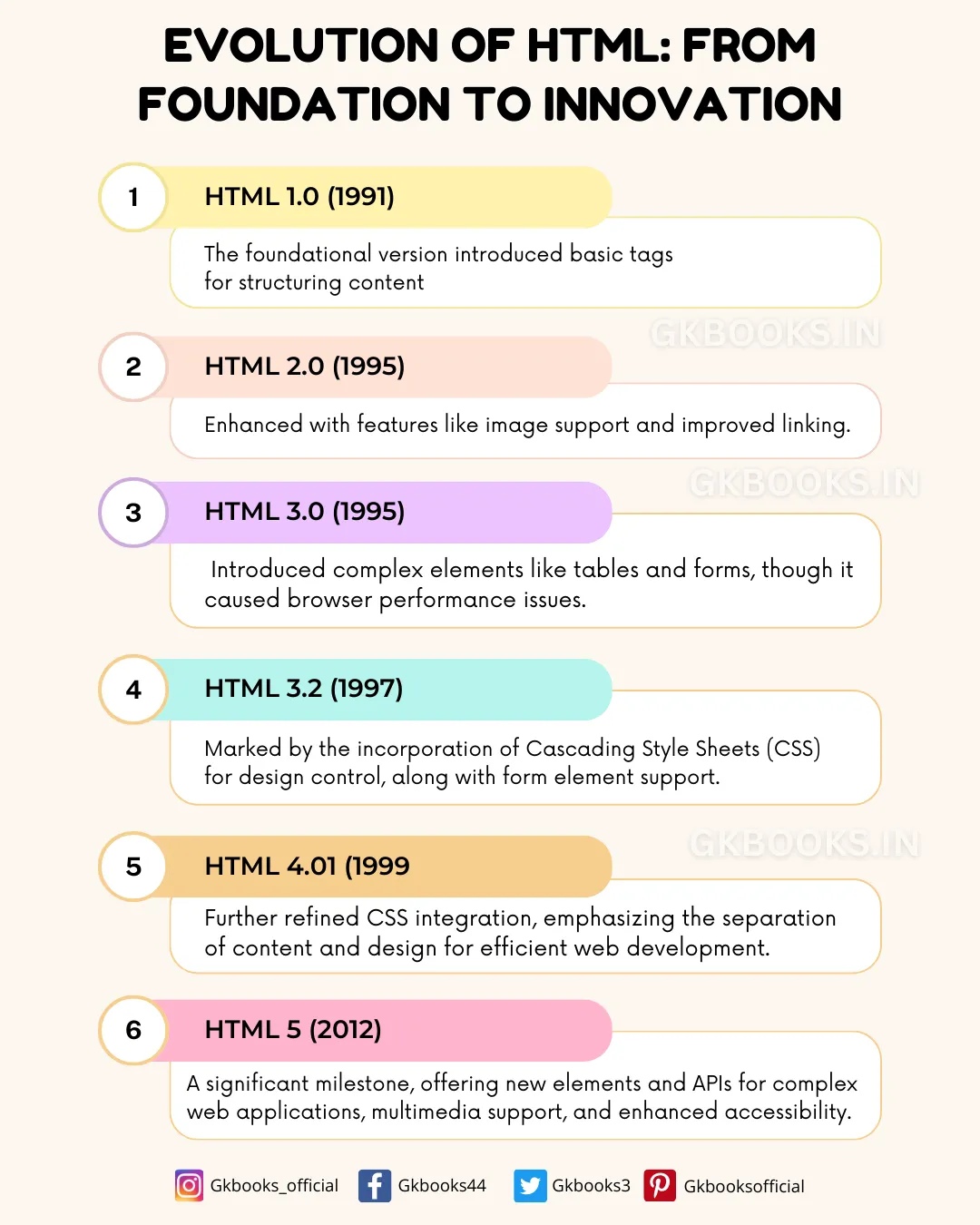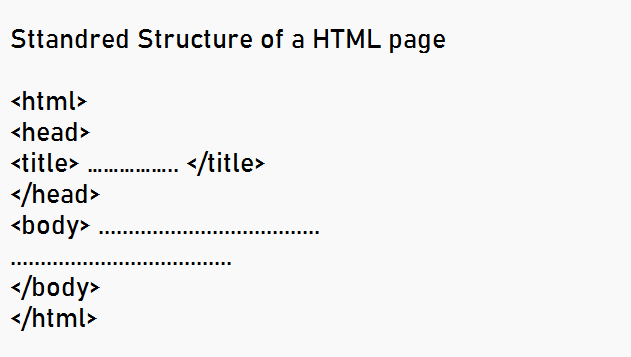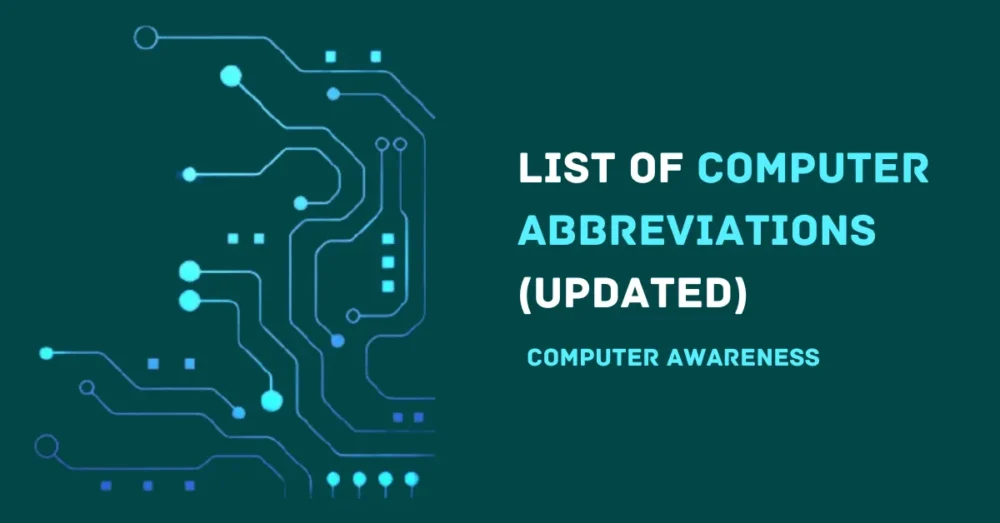HTML, or Hypertext Markup Language, is like the skeleton of a webpage. It’s a standard language that tells web browsers, like Chrome or Safari, how to display the content on the screen. When you visit a website, everything you see, from the headings to the paragraphs, is structured using HTML.
The article you read here is also structured with the help of HTML. All the bullet points, headings, titles, subheadings, and tables are created using HTML
Understand the parts of HTML
Here’s a simple way to understand the parts of HTML:
- Hypertext: This is the ‘hyper’ part of HTML. It’s what allows you to click on links and jump from one page to another. Imagine it like a magical bridge between web pages.
- Markup: Think of this as the instructions for setting up a tent. Just like how you follow steps to put up a tent, a browser follows the markup to build a webpage.
- Language: This is the set of rules that the markup follows. It’s like the grammar in English that helps us make sense of words and sentences.
Now, HTML by itself is pretty plain. It’s like a coloring book before you’ve added any color. That’s where CSS (Cascading Style Sheets) comes in. CSS is like the set of crayons that makes your website look colorful and stylish. It controls the design, like the colors, fonts, and layout.
And then there’s JavaScript (JS), which is like the magic wand that brings a webpage to life. It makes websites interactive, so things can move, change, or respond when you click on them.
Together, these three make a website that’s not only informative but also engaging and fun to use
✅ Read also: OTT Full Form in Media, Types of OTT
Comparison with Human Body
Let’s compare HTML, CSS, and JavaScript to the human body to understand them more clearly and concisely.
- HTML is like the skeletal system of the human body. It provides the basic structure and shape to a webpage, just as bones provide the framework for our bodies.
- CSS is akin to the muscles and skin, which give the body its appearance. In web design, CSS styles the HTML structure with colors, layouts, and fonts, creating an attractive and recognizable look.
- JavaScript can be compared to the nervous system. It’s responsible for the interactive elements and dynamic behavior on a webpage, similar to how our nervous system controls movement and responses to stimuli.
So, if you’re curious and want to create your own website, starting with HTML is a great first step. It’s like learning to build with blocks before moving on to more complex toys. And who knows? Maybe one day, you’ll be the one creating websites that everyone around the world visits!
Who designed HTML?
- HTML, which stands for HyperText Markup Language, was designed by Tim Berners-Lee. He is a computer scientist from Britain credited with inventing the World Wide Web.
- While working at CERN, the European Organization for Nuclear Research, he developed HTML in 1990 as a way to create and share documents across the internet. This invention has significantly shaped the digital world we know today.
✅ Read also: Web Browser, History, Types, Function, Features, and More
What was the motivation behind creating HTML?
- The motivation behind creating HTML was to address the need for a simple, flexible language that could format and link documents across different computers connected to the internet.
- Tim Berners-Lee, while working at CERN, recognized the potential for a global network of information that could be easily accessed and shared.
- He envisioned a system where researchers around the world could share their documents, data, and findings in a standardized format, regardless of the hardware or software they were using.
- HTML was designed to be straightforward enough for non-technical people to use, allowing them to create web pages without requiring extensive programming knowledge.
- This simplicity and universality were key motivations, as they would enable the widespread adoption and collaboration that Berners-Lee sought for his vision of an interconnected world.
The creation of HTML was a pivotal moment in the development of the World Wide Web, as it provided the means for creating the vast, interconnected information system we use today.
✅ Read also: CD-ROM full form in Computer
How did HTML evolve after its initial creation?
HTML, or HyperText Markup Language, has undergone significant evolution since its inception. Here’s a brief overview of its development:
- HTML 1.0: Created by Tim Berners-Lee in the year 1991.
- HTML 1.0 For developers: HTML 1.0 was first released in 1993 for developers. It was the first version of HTML and provided a basic set of tags for structuring content.
- HTML 2.0: Released in 1995, this version included all the features of HTML 1.0 along with additional features like image support and improved linking. It remained the standard until January 1997.
- HTML 3.0: Extended version of HTML 2.0. This version introduced more advanced features, including tables and forms, but it also slowed down browsers due to its complexity.
- HTML 3.2: HTML 3.2, established by W3C in 1997, was a pivotal step in web development. It introduced form element support and notably incorporated Cascading Style Sheets (CSS) for enhanced design control.
- HTML 4.01: Published in late 1999, HTML 4.01 also included cascading style sheets (CSS), which allowed for easier alteration of text, colour, font, and backgrounds. This separation of content and design made web development more efficient.
- HTML 5: The current version, HTML 5, was released in 2012. It is an extended version of HTML 4.01 and includes new elements and APIs for complex web applications, improved multimedia support, and enhanced accessibility options.
Each version of HTML has allowed users to create web pages in a much easier and prettier way, making sites more efficient and interactive. The World Wide Web Consortium (W3C) has played a crucial role in developing these standards to ensure compatibility and functionality across different web browsers and devices.

Common Tags in HTML
Let’s explore some common HTML tags that are widely used in structuring a webpage.
‘td’ Tag
- In HTML ‘td’ stands for table data. This table data tag starts with the opening tag “<td>” and closes with the tag ‘</td>’.
- “<td>……..</td>” It is known as a Table Data Cell element. The element defines a cell of a table that contains some data.
‘hr’ Tag
- In HTML full form the “hr” tag stands for the horizontal rule. This “<hr>” tag has no closing tag that is “</hr>”.
- On a web page, it is used to insert a horizontal rule a thematic break or simply a line separator to divide or separate sections of a document.
‘href’ Tag
- In HTML full form the ‘href’ tag stands for Hypertext Reference. This HTML tag is used to create a hyperlink to another page. The ‘href’ is an attribute of the anchor tag.
‘br’ Tag
- ‘br’ stands for ‘break’. The ‘<br>’ element tag is used to break the line as we use the ‘keyboard enter’ key on the notepad for simple plain text to break the line.
More examples of HTML Tags
<html>….</html>: The root of the HTML document.
<head>….</head>: Contains head elements such as title, style, and meta tags.
<title>…..</title>: Defines the title of an HTML document.
<body>…</body>: Defines the body of an HTML document, containing content like images, tables, and lists.
<div>...</div>: Defines a division or section in an HTML document.
<p>...</p>:Defines a paragraph.
<a>...</a>: Defines a hyperlink.
<img>...</img>: Embeds an image.
<ul>...</ul>: Defines an unordered list.
<ol>...<ol>:Defines an ordered list.
<li>...</li>: Defines a list item.
<table>...</table>: Defines a table.
<tr>...</tr>: Defines a table row.
<th>...</th>: Defines a table header cell.
<form>...</form>: Defines an HTML form for user input.
<input>: Defines an input control within a form.
<button>...</button>: Defines a clickable button.
<h1> to <h6>: Define headings of different levels.
<span>...</span>: Defines a generic inline container.
<label>...</label>: Defines a label for an input element.
<iframe>...</iframe>: Embeds an inline frame for external content.
✅ Download HTML Tags List with Examples PDF: Important for Competitive Exams Aspirants
How HTML Works
HTML, short for HyperText Markup Language, serves as the universal standard for creating web pages. It works by using a system of tags and attributes to define the structure and layout of a webpage. Here’s a basic overview of how HTML functions:
- Tags & Elements: HTML uses tags to denote different elements like headings, paragraphs, links, images, and more. Each element typically has an opening tag like
<p>and a closing tag like</p>to frame the content.
- Attributes: Elements can have attributes that provide additional information about the element. For example, the
srcattribute in an<img>tag specifies the URL of the image to be displayed.
- Document Structure: An HTML document starts with a
<!DOCTYPE html>declaration, followed by an<html>element that wraps the entire content. Inside, there’s a<head>section for metadata and a<body>section for the content that appears on the page.
- Web Browsers: Browsers read HTML documents and render them into visual web pages. They interpret the tags and structure to present the content in a formatted way.
Here’s a simple example of an HTML document:
<!DOCTYPE html>
<html>
<head>
<title>Page Title</title>
</head>
<body>
<h1>My First Heading</h1>
<p>My first paragraph.</p>
</body>
</html>
In this example, the <title> tag sets the page’s title, <h1> defines a top-level heading, and <p> defines a paragraph. This is the foundation upon which all web pages are built.
Standard Structure of an HTML page

Explanation of the HTML Structure
- In HTML, we use different elements within HTML tags for formatting text and displaying audio and video. Most of the elements in HTML, start with an opening tag (<>) and end with a closing tag(</>).
- Less than (<) and Greater than(>), these two signs, formed HTML opening and closing tags. We put a particular attribution between these two signs to perform a task. As an example, for “bold text” we use “<b>……</b>”. B for bold and ‘</b>’ is a closing tag.
- So, “<HTML>” is an HTML opening tag and “</HTML>” is a closing tag of an HTML document. Every HTML code should begin with”<HTML>” tag and end with”</HTML>” tag.
- Similarly, Your page title should be written in the title opening and closing tag, Such as
- “<TITLE>HTML FULL FORM</TITLE>”.
- Head tag “<HEAD>” contains header information and other additional web development codes.
- Your main content should be written in the Body tag. [<BODY>…………</BODY>]
Advantages of HTML
Here are some brief advantages of HTML:
- Easy to Learn and Use: HTML is known for its straightforward syntax and ease of learning, making it accessible for beginners in web development.
- Free and Open-Source: It’s a free, open-source language that doesn’t require any specific software or plugins to work.
- Widely Supported: HTML is supported by all web browsers, ensuring compatibility across different platforms.
- Lightweight: HTML documents are light and fast to load, which contributes to better performance of web pages.
- Versatile Integration: It integrates easily with other web technologies like CSS and JavaScript, allowing for more complex and dynamic web pages.
- Flexible: HTML allows changes to be made at any time, accommodating updates and maintenance needs.
These advantages make HTML a fundamental building block for creating web content.
Disadvantages of HTML
Here are some brief disadvantages of HTML:
- Static Nature: HTML can only create static pages, which means it cannot produce dynamic content that changes in response to user actions without the help of other technologies like JavaScript.
- Complexity with Large Documents: As the size and complexity of an HTML document grow, it can become difficult to manage and maintain, especially when dealing with numerous nested tags.
- Limited Styling and Presentation: HTML alone doesn’t offer much control over the visual presentation of a webpage. For more sophisticated styling, you need to use CSS (Cascading Style Sheets).
- Time-Consuming for Some Tasks: Certain tasks, such as creating lists, tables, and forms, can be time-consuming in HTML because they require a lot of code for simple functions.
- Security Limitations: HTML provides limited security features, so it must be used in conjunction with other technologies to ensure secure web applications.
- Costly Errors: Mistakes in HTML can be costly because they may not be immediately apparent and can cause issues with the layout or functionality of a webpage.
These disadvantages highlight areas where HTML needs to be supplemented by other languages or technologies to create a complete and dynamic web experience.
Frequently Asked Questions (FAQ)
Ans. The full form of HTML is HyperText Markup Language.
Ans. The full form of a computer is HyperText Markup Language.
Ans. HTML stands for source code file.
Ans.. The full form of href is Hypertext REFerence
Ans. In HTML stands for “Break”
Ans. The full form of tr in HTML is “table row”
Ans. UL stands for Unordered lists.
Ans. In HTML td stands for “Table row”
Ans. In HTML hr stands for “Horizontal Rule”






